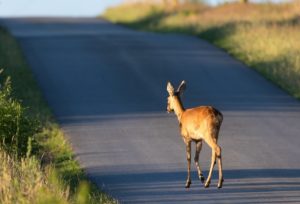How to Avoid Deer Accidents
Posted in Accident & Injury on September 27, 2017
 Nobody wants to hit a deer on the road, but such accidents are far more common than you think. According to the Federal Highway Administration, there may be between one and two million animal-vehicle collisions (AVCs) per year in the U.S. Other estimates hint at more than $1 billion in property damage and more than 100 deer-involved human deaths each year.
Nobody wants to hit a deer on the road, but such accidents are far more common than you think. According to the Federal Highway Administration, there may be between one and two million animal-vehicle collisions (AVCs) per year in the U.S. Other estimates hint at more than $1 billion in property damage and more than 100 deer-involved human deaths each year.
What can you do to decrease the likelihood that you will be involved in an accident involving a deer?
Universal safety precautions
Some deer-involved car and truck accidents occur because of preventable driver errors. It is essential to follow these universal safety precautions:
- Remember that speed kills: Excessive speed makes it harder to stop even if you do see a deer coming. Sticking to posted speed limits, especially when visibility is lower, will keep you safer.
- Avoid distractions: In most places, it is illegal to drive while texting or accessing social media, websites or email on your phone. Both outlawed behaviors and legal distractions (like taking your eyes off the road to change a CD, apply makeup or fumble with your sandwich wrapper) can greatly impair your response time when a hazard appears on the road in front of you.
- Know your own limits, and don’t drink and drive: Be aware of how alcohol and other substances affect your ability to drive. Alcohol and drugs, including some prescription drugs and over-the-counter medications, can make it much harder for you to drive safely, even if you are not legally intoxicated.
- Watch out for fatigue: Many nighttime and morning accidents happen because drivers are simply tired. Fatigue will make it harder for you to stay focused and react quickly enough if a deer suddenly runs in front of your vehicle.
Deer-specific safety precautions
Animals do many things that are hard to predict, but experts have identified certain deer behavior patterns. Being informed could save your life:
- Know where deer are active: Be mindful of “Deer Crossing” signage. It’s there for a reason. Reduce your speed at night if you are unfamiliar with a route, or even if you know a road well. Be especially cautious in areas identified as deer populated.
- Know when deer are active: Be particularly careful at dawn and dusk, when deer are more likely to move in search of food. Be aware of seasonal deer activities like mating, which typically occurs in the fall.
- Use proper lighting: Use maximum illumination when driving at night. The sooner you can see an animal on the road, the greater your chance of avoiding a collision.
Free attorney consultation
Every accident is different. Talk to an attorney from Elk & Elk by calling 1-800-ELK-OHIO.